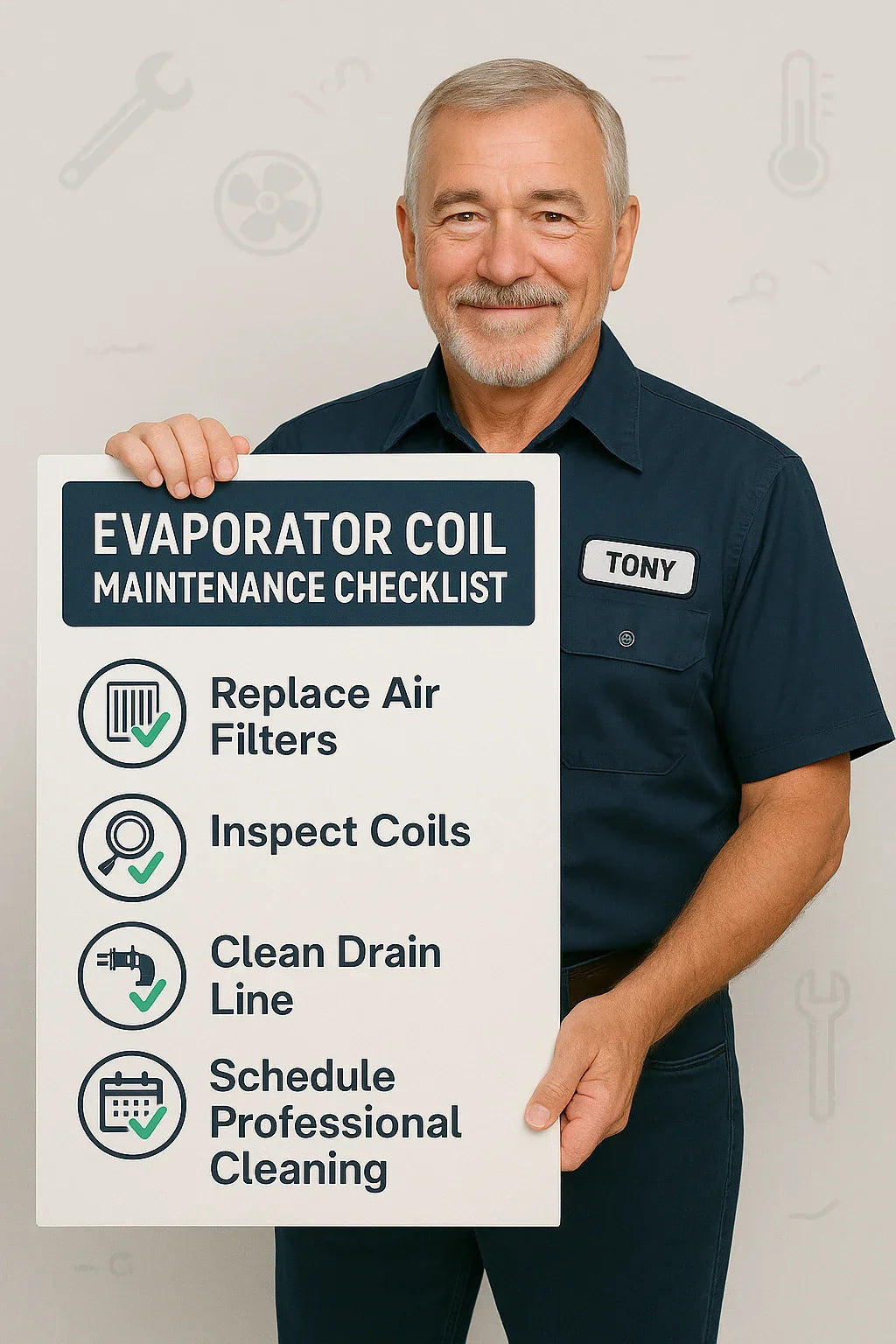Introduction: The Silent Workhorse Deserves Some Attention
You wouldn’t let your car go years without an oil change, right? But many homeowners neglect a critical component of their HVAC system for years: the evaporator coil. Even though it's tucked away inside your air handler, your evaporator coil quietly handles the toughest job—pulling heat and moisture from your home’s air.
The problem? Dirt, dust, and moisture can turn that efficient coil into a gunky, inefficient mess. Over time, a dirty evaporator coil can increase your energy bills, reduce comfort, shorten your system’s life, and cause expensive breakdowns.
In this comprehensive guide, Tony will walk you through everything you need to know about cleaning and maintaining your evaporator coil to maximize efficiency, comfort, and equipment longevity.
Why Evaporator Coil Maintenance Matters So Much
-
Energy Efficiency: Even a thin layer of dust can reduce heat transfer by 10%-30%.
-
Comfort: Clean coils remove more heat and humidity, improving indoor comfort.
-
System Longevity: Dirty coils cause compressor strain and premature failure.
-
Indoor Air Quality: Mold or mildew growth on coils circulates spores into your home.
Energy Star - HVAC Maintenance Guide
How Often Should You Clean Your Evaporator Coil?
Tony’s Golden Rule:
"Once a year for most homes. Twice a year if you have pets, allergies, or live in high-dust environments."
-
Spring: Ideal time before heavy cooling season.
-
Fall: For homes running year-round HVAC.
Signs Your Coil Needs Cleaning
-
Reduced cooling performance.
-
Higher energy bills.
-
Warm air blowing from vents.
-
Musty odors from the air handler.
-
Ice formation on refrigerant lines or coil.
The Cleaning Process: DIY vs. Professional Service
While some light maintenance can be homeowner-friendly, full cleaning often requires professional expertise. Let’s break it down:
Homeowner Maintenance Tasks
1. Replace Air Filters Regularly
-
Prevents dust buildup on coils.
-
Change every 1-3 months depending on usage.
2. Visual Inspections
-
Check access panel for visible dust or debris.
-
Look for mold growth or water leaks.
3. Condensate Drain Line Maintenance
-
Flush with vinegar every 2-3 months.
-
Prevents algae or mold clogs.
Professional Coil Cleaning Tasks
1. Foam Coil Cleaning
-
Technician sprays non-acidic foam cleaner.
-
Dissolves dirt and debris safely.
2. Blow-Out or Vacuum Cleaning
-
Compressed air or vacuum gently removes loosened debris.
3. Deep Chemical Cleaning
-
For heavily soiled coils.
-
May require coil removal in extreme cases.
4. Blower Motor and Drain Pan Cleaning
-
Ensures full system cleanliness.
The Spruce - How to Clean an HVAC Coil
Professional Coil Cleaning: What to Expect
Average Cost: $150 - $450
| Service Type | Estimated Cost |
|---|---|
| Light surface cleaning | $150 - $250 |
| Deep chemical cleaning | $300 - $450 |
| Coil removal & cleaning | $500+ (rare, extreme cases) |
-
Cleaning takes 1-2 hours.
-
Most reputable contractors bundle coil cleaning with annual maintenance plans.
The Hidden Dangers of Dirty Evaporator Coils
1. Compressor Failure
-
The compressor overworks trying to compensate for reduced heat transfer.
-
Replacement cost: $1,000 - $2,500
2. Frozen Coils
-
Ice forms as airflow is restricted.
-
Leads to full system shutdown.
3. Increased Humidity
-
Dirty coils remove less moisture.
-
Creates perfect conditions for mold growth.
4. Indoor Air Quality Issues
-
Circulates mold spores, dust mites, and allergens.
EPA - Indoor Air Quality and HVAC Maintenance
What Causes Evaporator Coils to Get Dirty?
-
Infrequent filter changes
-
Poorly sealed ductwork
-
Pet hair & dander
-
High pollen count areas
-
Nearby construction dust
-
Moisture buildup inside air handler
Drain Line Maintenance: The Overlooked Companion Task
Your evaporator coil doesn’t just cool air—it removes humidity. That moisture exits through the condensate drain line.
-
Algae and mold often clog these lines.
-
Overflow can cause serious water damage.
Simple Preventive Drain Maintenance:
-
Mix 1 cup vinegar + 1 cup water.
-
Pour down the drain line every 2-3 months.
-
Install a float switch for automatic shutoff if clog detected.
Family Handyman - How to Clean Condensate Drain Line
Tony’s Take: What I Tell My Customers
"Every HVAC system I’ve ever seen fail prematurely usually had one thing in common—neglected coils. The good news? A little attention goes a long way. Schedule regular cleanings, replace those filters, and don’t ignore warning signs. It’s like brushing your system’s teeth."
When Is It Time to Replace Rather Than Clean?
| Condition | Recommended Action |
| Light surface dirt | Clean |
| Minor mold or mildew | Clean + sanitize |
| Heavy corrosion | Clean cautiously |
| Severe refrigerant leaks | Replace |
| Repeated freezing issues | Full evaluation |
| System age 12-15+ years | Consider replacement |
FAQs: Coil Cleaning and Maintenance
Can I clean the coil myself?
Yes—surface dust can be vacuumed gently. For anything deeper, hire a pro.
Is annual professional cleaning worth it?
Absolutely. Prevents major repairs and keeps your system running at peak efficiency.
Can dirty coils void my HVAC warranty?
In some cases, yes. Manufacturers require documented maintenance.
What’s the best coil cleaner for homeowners?
Non-acidic foaming cleaners sold at hardware stores (safe for aluminum & copper).
The Bottom Line: Don’t Forget What You Can’t See
Your evaporator coil works quietly out of sight—but it’s doing the heavy lifting every time you run your air conditioner or heat pump. Neglecting it may not cause immediate failure, but it’s a slow ticking time bomb for efficiency, comfort, and repair costs.
With proper cleaning and maintenance, your coil can easily last 15+ years while keeping your home cool, comfortable, and healthy. Partnering with trusted suppliers like The Furnace Outlet ensures you have access to quality replacement coils when that day eventually arrives.
In the next article we will know about: Best Evaporator Coil Brands: Goodman vs. Carrier vs. Rheem vs. Trane







